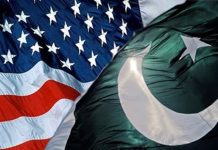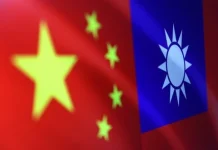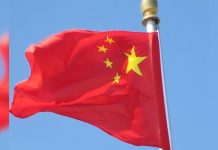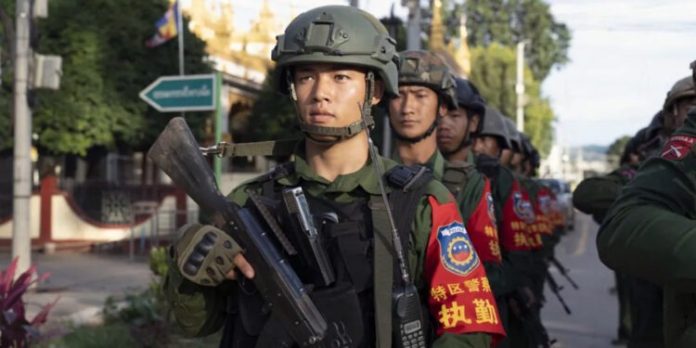Leaked details of an August 27 meeting between China’s special envoy to Myanmar, Deng Xijun, and the powerful United Wa State Army (UWSA) reveal the armed group was told to employ the “four cuts” strategy against the Myanmar National Democratic Alliance Army (MNDAA) and the Ta’ang National Liberation Army (TNLA) to halt their offensives against the regime.
The four cuts refer to cutting off access to food, funds, information, and recruits.
China last month closed border crossings in northern Shan State where the two ethnic armed organizations (EAOs) are based, cutting off supplies to the MNDAA and TNLA to pressure them into peace talks with the regime.
Deng reiterated that China did not want northern Myanmar’s EAOs to engage with the civilian National Unity Government and its armed wing, the People’s Defense Force (PDF).
The meeting gave rise to speculation of an imminent shift in Myanmar’s political situation as China reins in the ethnic armies.
However, the assumption that China has control over EAOs in northern Myanmar is incorrect.
Are EAOs in northern Myanmar under China’s thumb?
There are seven EAOs based in northern Myanmar: the Shan State Progress Party/Shan State Army (SSPP/SSA) and Kachin Independence Army (KIA), formed in 1958-1960; the UWSA, MNDAA, and the National Democratic Alliance Army, which split from the Communist Party of Burma (CPB); the Arakan Army (AA), formed in 2009; and the TNLA which re-formed in late 2009.
It is reasonable to assume that the three groups that broke away from the CPB have ties with Beijing. However, they have not received any weapons or ammunition from China since splitting from the CPB.
The SSPP and KIA acquired some weapons from China through the CPB, but received nothing after the CPB’s collapse. Similarly, neither the AA nor TNLA has received weapons from China.
They can however purchase Chinese-made weapons at the border or from ordnance factories in Laos. Likewise, EAOs based near Thailand, such as the Restoration Council of Shan State, Karenni National Progressive Party, Karen National Union, and New Mon State Party, can buy US-made weapons like M-16 rifles at the Thai border.
While domestic and Western observers accuse China of arming EAOs based along its border, there is no evidence to support that claim. They don’t accuse EAOs based on the Thai border of being supplied by the US or Thai governments despite their use of US and Thai-made weapons.
China’s assistance
Beijing had two reasons to help the CBP in 1968: to back the communist cause and to establish a buffer zone against Washington-backed Kuomintang troops threatening the border. For these reasons, China amply supplied the CPB.
China forged diplomatic ties with the US in 1970, after which Washington stopped backing the Kuomintang while China withdrew support from armed insurgents in Myanmar.
After the CPB collapsed in 1989, Beijing forged close ties with successive Myanmar military regimes, first the State Peace and Development Council and then the State Law and Order Restoration Council (SLORC). As a result, China became Myanmar’s major arms supplier and biggest trade partner and investor, reaping huge benefits. It also used its veto power to back the military regime at the United Nations.
For China, supplying arms to opponents of Myanmar’s junta would only harm its interests in the country. Regardless of the political system adopted by the regime, China will maintain ties with the Myanmar military to protect its own interests.
Except for the Myanmar military, no armed groups were operating in the western Rakhine State or Magwe and Mandalay regions in central Myanmar when the US$ 3-billion China-Myanmar oil and gas pipelines were opened around 2007-2008. The TNLA had yet to form in northern Shan State. The KIA was the only EAO controlling territory traversed by the pipeline, and it had signed a truce with the Myanmar military. The MNDAA was confined to Laukkai.
The territory traversed by the pipelines remained stable under Myanmar military control, with no fighting occurring. Instability in this region would have only harmed China’s interests.
These interests include border trade, the Kyaukphyu special economic zone and deep seaport in Rakhine State, and a railroad linking Kyaukphyu with the Chinese border town of Ruili, all of which require a stable Myanmar.
As such, allegations that China has incited and supplied arms to EAOs in northern Myanmar are groundless and ridiculous.
Upheaval for EAOs in northern Myanmar
In 2009, changes arose among ethnic armies along the Chinese border due to flawed policies and thoughtless actions of Myanmar’s military leadership. The junta ordered EAOs to disarm and transform into militias or border guard forces – but key armed groups resisted.
The military launched an offensive against Peng Jiasheng’s MNDAA in 2009, driving his troops out of Kokang. The offensive undermined the trust that the UWSA and National Democratic Alliance Army (NDAA) had in the Myanmar military. The KIA also refused to yield to the junta’s demand, resulting in fighting two years later.
Two of the SSPP’s brigades meanwhile agreed to rebadge as border forces, but the third fought back against the regime.
The MNDAA attempted to re-form in Laukkai, while the ethnic Rakhine and Ta’ang people began organizing their own armed groups with KIA help. The resulting EAOs are products of policy blunders by the Myanmar junta. China neither created these groups nor supported their growth.
Brotherhood Alliance grows stronger
The junta launched peace talks in 2011 but barred the MNDAA, TNLA and AA – which would go on to form the ethnic Brotherhood Alliance – from signing the Nationwide Ceasefire Agreement (NCA) in 2015. The following year, it issued an ultimatum to KIA Brigade 4 and the Brotherhood Alliance to disarm, while also pressuring the UWSA and NDAA to sign the NCA. This led to the formation of political and military alliances between EAOs in northern Myanmar.
Deprived of political guarantees, the UWSA and the NDAA began assisting other armed groups, facilitating the growth of the Brotherhood Alliance.
China’s stance on border EAOs
During his tenure as China’s special envoy, Sun Guoxiang continuously pressured EAOs to sign the NCA they boycotted in 2015. He also mediated talks between the Myanmar military and the three border-based EAOs.
Deng Xijun, who replaced Sun in late 2022, held numerous meetings with the Brotherhood Alliance to halt their offensive against the regime.
After the Brotherhood launched Operation 1027 in October 2023, Deng held four rounds of talks with alliance representatives in less than three months, finally pressuring them to sign a truce in mid-January. Deng threatened China would close border crossings and cut off supplies of food, medicines, fuel and consumer goods if they refused to lay down arms.
So, it was not surprising to see China’s special envoy repeat the threats against the three EAOs after the Brotherhood Alliance resumed fighting in June.
China has protected Myanmar’s military regime since the coup in 2021. Beijing desires access to the Indian Ocean through Myanmar and wants the regime to maintain its control and stabilize the country.
Supporting or supplying arms to ethnic armed groups is thus not in China’s interest.
Despite accusations of Chinese support, the EAOs’ significant territory gains in northern Shan State and beyond have been achieved independently through years of hard effort. They consider it an insult to be branded as stooges of Beijing.
Far from aiding the EAOs, China has repeatedly pressured them to stop fighting. During his tenure, Sun Guoxiang made weekly phone calls to the Brotherhood Alliance. His successor, Deng, has reportedly increased the pressure, phoning them every three days.
Changes?
The reports of China pressuring the Brotherhood Alliance have prompted junta lobbyists and so-called scholars to predict imminent changes in the country’s civil war.
However, these predictions overlook the fact that the Brotherhood Alliance is fighting the regime of its own volition, despite pressure from China.
The alliance launched phase two of Operation 1027 fully aware that China might respond by cutting them off.
Meanwhile, groups such as the UWSA, NDAA and SSPP are all aware that they can’t distance themselves from their fellow EAOs in the absence of a deal with the current regime.
Given that the Brotherhood Alliance have enjoyed no support and only constant pressure from Beijing, China’s moves are unlikely to affect their military operations. On the contrary, the alliance is strengthening ties with resistance forces in Myanmar’s heartland, further accelerating the momentum of the Spring Revolution.









































